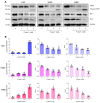Pharmacological Ascorbate Elicits Anti-Cancer Activities against Non-Small Cell Lung Cancer through Hydrogen-Peroxide-Induced-DNA-Damage
- PMID: 37760080
- PMCID: PMC10525775
- DOI: 10.3390/antiox12091775
Pharmacological Ascorbate Elicits Anti-Cancer Activities against Non-Small Cell Lung Cancer through Hydrogen-Peroxide-Induced-DNA-Damage
Abstract
Non-small cell lung cancer (NSCLC) poses a significant global health burden with unsatisfactory survival rates, despite advancements in diagnostic and therapeutic modalities. Novel therapeutic approaches are urgently required to improve patient outcomes. Pharmacological ascorbate (P-AscH-; ascorbate at millimolar concentration in plasma) emerged as a potential candidate for cancer therapy for recent decades. In this present study, we explore the anti-cancer effects of P-AscH- on NSCLC and elucidate its underlying mechanisms. P-AscH- treatment induces formation of cellular oxidative distress; disrupts cellular bioenergetics; and leads to induction of apoptotic cell death and ultimately reduction in clonogenic survival. Remarkably, DNA and DNA damage response machineries are identified as vulnerable targets for P-AscH- in NSCLC therapy. Treatments with P-AscH- increase the formation of DNA damage and replication stress markers while inducing mislocalization of DNA repair machineries. The cytotoxic and genotoxic effects of P-AscH- on NSCLC were reversed by co-treatment with catalase, highlighting the roles of extracellular hydrogen peroxide in anti-cancer activities of P-AscH-. The data from this current research advance our understanding of P-AscH- in cancer treatment and support its potential clinical use as a therapeutic option for NSCLC therapy.
Keywords: DNA damage; adjuvant; anti-cancer; ascorbic acid; non-small cell lung cancer; oxidative distress; pharmacological ascorbate; pro-oxidant; vitamin C.
Conflict of interest statement
The authors declare no potential conflict of interest. Kittipong Sanookpan, M.Sc. currently holds the position as Research Manager of Nabsolute Co., Ltd. It is important to note that the Nabsolute Co., Ltd. was not involved in the study’s design, data collection, data analysis, data interpretation, manuscript preparation or the decision to publish the findings of this research.
Figures











Similar articles
-
Pharmacological ascorbate combined with rucosopasem selectively radio-chemo-sensitizes NSCLC via generation of H2O2.Redox Biol. 2025 Mar;80:103505. doi: 10.1016/j.redox.2025.103505. Epub 2025 Jan 23. Redox Biol. 2025. PMID: 39884000 Free PMC article.
-
Pharmacologic Ascorbate Primes Pancreatic Cancer Cells for Death by Rewiring Cellular Energetics and Inducing DNA Damage.Mol Cancer Res. 2019 Oct;17(10):2102-2114. doi: 10.1158/1541-7786.MCR-19-0381. Epub 2019 Jul 23. Mol Cancer Res. 2019. PMID: 31337671 Free PMC article.
-
Catalase Modulates the Radio-Sensitization of Pancreatic Cancer Cells by Pharmacological Ascorbate.Antioxidants (Basel). 2021 Apr 16;10(4):614. doi: 10.3390/antiox10040614. Antioxidants (Basel). 2021. PMID: 33923601 Free PMC article.
-
Auranofin and Pharmacologic Ascorbate as Radiomodulators in the Treatment of Pancreatic Cancer.Antioxidants (Basel). 2022 May 14;11(5):971. doi: 10.3390/antiox11050971. Antioxidants (Basel). 2022. PMID: 35624835 Free PMC article. Review.
-
Pharmacological Ascorbate as a Means of Sensitizing Cancer Cells to Radio-Chemotherapy While Protecting Normal Tissue.Semin Radiat Oncol. 2019 Jan;29(1):25-32. doi: 10.1016/j.semradonc.2018.10.006. Semin Radiat Oncol. 2019. PMID: 30573181 Free PMC article. Review.
Cited by
-
Facts, Dogmas, and Unknowns About Mitochondrial Reactive Oxygen Species in Cancer.Antioxidants (Basel). 2024 Dec 19;13(12):1563. doi: 10.3390/antiox13121563. Antioxidants (Basel). 2024. PMID: 39765891 Free PMC article. Review.
-
Multi-omics reveals the associations among the fecal metabolome, intestinal bacteria, and serum indicators in patients with hepatocellular carcinoma.World J Gastroenterol. 2025 Apr 21;31(15):104996. doi: 10.3748/wjg.v31.i15.104996. World J Gastroenterol. 2025. PMID: 40309232 Free PMC article.
-
Endoscopic surgery affects the gut microbiota and its metabolism in breast cancer patients.Front Microbiol. 2025 Jan 7;15:1481582. doi: 10.3389/fmicb.2024.1481582. eCollection 2024. Front Microbiol. 2025. PMID: 39839115 Free PMC article.
-
High-dose Ascorbate Exhibits Anti-proliferative and Anti-invasive Effects Dependent on PTEN/AKT/mTOR Pathway in Endometrial Cancer in vitro and in vivo.Int J Biol Sci. 2025 Jan 27;21(4):1545-1565. doi: 10.7150/ijbs.102079. eCollection 2025. Int J Biol Sci. 2025. PMID: 39990670 Free PMC article.
References
-
- Garon E.B., Hellmann M.D., Rizvi N.A., Carcereny E., Leighl N.B., Ahn M.J., Eder J.P., Balmanoukian A.S., Aggarwal C., Horn L., et al. Five-year overall survival for patients with advanced non-small-cell lung cancer treated with pembrolizumab: Results from the phase I KEYNOTE-001 Study. J. Clin. Oncol. 2019;37:2518–2527. doi: 10.1200/JCO.19.00934. - DOI - PMC - PubMed
-
- Buranasudja V., Doskey C.M., Gibson A.R., Wagner B.A., Du J., Gordon D.J., Koppenhafer S.L., Cullen J.J., Buettner G.R. Pharmacologic ascorbate primes pancreatic cancer cells for death by rewiring cellular energetics and inducing DNA damage. Mol. Cancer Res. 2019;17:2102–2114. doi: 10.1158/1541-7786.MCR-19-0381. - DOI - PMC - PubMed
Grants and funding
LinkOut - more resources
Full Text Sources

